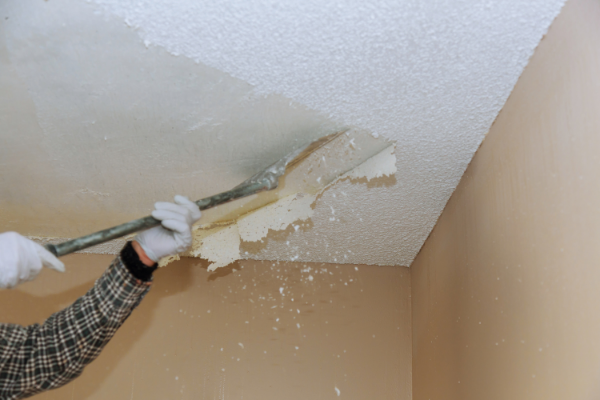 During the 1970s, home building picked up on the idea of a cheap but effective way to reduce sound travel from one floor to the next: popcorn ceilings. Essentially, after the drywall was installed, a finisher would come in with a plaster mix and spray on the ceiling drywall for a bit of a lumpy effect. The disparate clumps and bumps not only created a texture to an otherwise flat-looking ceiling, they also helped break up sound waves. After being spray-painted in white, the ceiling texture essentially blended with the rest of the room to produce a finished look. Popcorn ceilings were such a common approach, entire home subdivisions had cookie-cutter ceiling work done by teams on new homes.
During the 1970s, home building picked up on the idea of a cheap but effective way to reduce sound travel from one floor to the next: popcorn ceilings. Essentially, after the drywall was installed, a finisher would come in with a plaster mix and spray on the ceiling drywall for a bit of a lumpy effect. The disparate clumps and bumps not only created a texture to an otherwise flat-looking ceiling, they also helped break up sound waves. After being spray-painted in white, the ceiling texture essentially blended with the rest of the room to produce a finished look. Popcorn ceilings were such a common approach, entire home subdivisions had cookie-cutter ceiling work done by teams on new homes.
A Bad Memory From the Past
Today, popcorn ceilings are like sheet vinyl on flooring, relics of the 1970s decade and almost a trigger for a negative gut reaction from anyone who lived in that time period, particularly as a kid. Worse, prior to 1978, some of the material used to create the popcorn ceiling also included asbestos under the idea that it would improve safety and increase fire resistance ( disregarding the fact that asbestos is extremely hazardous to breathe once airborne).
Leverage for a Buyer, Vulnerability for a Seller
No surprise, anyone in modern times coming into a used home as a new buyer and owner will likely want to have the popcorn ceiling texture completely removed and redone. In some cases, during a buyer’s market, some prospects will actually want the seller to pay for the work to sell the home quickly.
Sellers should expect, at a minimum, that the issue will be used to argue for a lower price, at least in a normal market or where there is competition to secure a buyer. Only during a seller’s market will the presence of the popcorn ceiling pretty much be a non-issue for a quick sale.
While it might seem tempting to just have the owner scrape the ceilings and repaint them, it’s best to have a professional take care of the removal in a clean process. Especially if the home is older than 1978, the work could be hazardous and require specific steps for proper mitigation.
 Last week’s scheduled economic reporting included readings on consumer prices, retail sales, and the University of Michigan’s preliminary Consumer Sentiment Index. Weekly readings on mortgage rates and jobless claims were also released.
Last week’s scheduled economic reporting included readings on consumer prices, retail sales, and the University of Michigan’s preliminary Consumer Sentiment Index. Weekly readings on mortgage rates and jobless claims were also released. Those who are taking out a loan for a home will probably be required by the lender to purchase home insurance. Even those who don’t need a loan will still need to make sure that they protect their property accordingly with a comprehensive home insurance policy. This is important for making sure homeowners have the money to replace their belongings and repair their property in the event of a disaster. At the same time, homeowners do not want to spend more than they must for a home insurance policy.
Those who are taking out a loan for a home will probably be required by the lender to purchase home insurance. Even those who don’t need a loan will still need to make sure that they protect their property accordingly with a comprehensive home insurance policy. This is important for making sure homeowners have the money to replace their belongings and repair their property in the event of a disaster. At the same time, homeowners do not want to spend more than they must for a home insurance policy.  Now is a great time to sell a home. Inventory is down to historic lows, according to recent reports, which means it’s a sellers’ market. Yes, many homeowners are reluctant to put their homes on the market for a variety of reasons. However, right now there are four big incentives for homeowners to sell, despite these objections.
Now is a great time to sell a home. Inventory is down to historic lows, according to recent reports, which means it’s a sellers’ market. Yes, many homeowners are reluctant to put their homes on the market for a variety of reasons. However, right now there are four big incentives for homeowners to sell, despite these objections. Title insurance is one of the few types of protection policies available to homebuyers and one that is often overlooked because of its optional nature.
Title insurance is one of the few types of protection policies available to homebuyers and one that is often overlooked because of its optional nature. Even though not every home has a basement, those that do usually fall into one of three categories. The most common examples of basements include poured concrete, masonry block basement, and precast panels. What do homeowners need to know about the different types of basement construction?
Even though not every home has a basement, those that do usually fall into one of three categories. The most common examples of basements include poured concrete, masonry block basement, and precast panels. What do homeowners need to know about the different types of basement construction?  Last week’s economic reporting was limited due to the Labor Day holiday. Job openings were reported along with weekly readings on mortgage rates and jobless claims.
Last week’s economic reporting was limited due to the Labor Day holiday. Job openings were reported along with weekly readings on mortgage rates and jobless claims. Homeowners need to make sure they maximize every square foot of their home. This includes the closet. Many people get frustrated when they look at their closets because they feel like they cannot find what they are looking for. Anyone who is struggling to keep their closet organizers should take a look at a few important points below.
Homeowners need to make sure they maximize every square foot of their home. This includes the closet. Many people get frustrated when they look at their closets because they feel like they cannot find what they are looking for. Anyone who is struggling to keep their closet organizers should take a look at a few important points below. There are different methods that home buyers may use to find a real estate agent to work with. While some may use the services of a real estate agent who they know personally, others may reach out to a professional who they have located online. Regardless of whether you previously knew the individual in a non-professional setting or not, it is important that you check your agent’s reference and testimonials before you get started with the home buying process. There are several good reasons for this.
There are different methods that home buyers may use to find a real estate agent to work with. While some may use the services of a real estate agent who they know personally, others may reach out to a professional who they have located online. Regardless of whether you previously knew the individual in a non-professional setting or not, it is important that you check your agent’s reference and testimonials before you get started with the home buying process. There are several good reasons for this. Due to recent changes in federal regulations, consumers are now allowed to freeze their credit free of charge. Prior to changes in these regulations, credit bureaus would charge consumers for freezing their credit. What does this mean, and why might someone want to do this?
Due to recent changes in federal regulations, consumers are now allowed to freeze their credit free of charge. Prior to changes in these regulations, credit bureaus would charge consumers for freezing their credit. What does this mean, and why might someone want to do this?